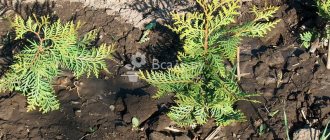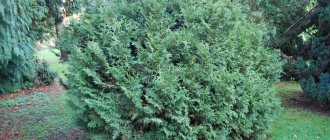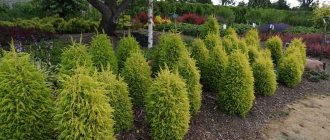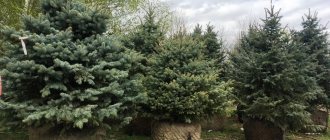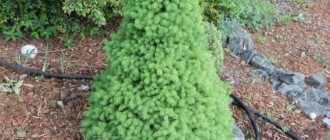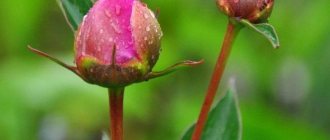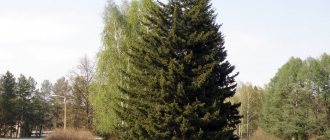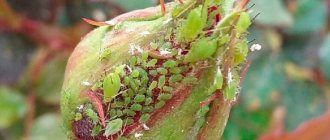Coniferous compositions are very popular in landscape design. Due to their high decorative qualities that last throughout the year, as well as the variety of shapes and types, pine needles are grown everywhere - in gardens, parks, alleys and along sidewalks. Despite their ease of care, not every gardener succeeds in growing coniferous plants beautiful and healthy. One of the main reasons for the death of this plant is its diseases and pests.
In this article we will tell you what types of diseases there are in spruce trees and their treatment; a photo description is given below.
What are the diseases of Christmas trees?
Prevention and... prevention again
What are the diseases of Christmas trees?
Today there are many varieties of spruce, which are represented by perennial trees and shrubs.
Let's consider diseases of Canadian, blue, common, konica and Serbian spruce. It is these species that are of greatest value in creating coniferous decorations. These varieties of needles are capable of growing in any climatic conditions, including in the Moscow region, as well as in the northern regions of the country. Therefore, many gardeners give preference to these species for creating decorative coniferous compositions in their garden. The most dangerous diseases of needles include
: Rust of needles.
This b
This disease appears in the spring.
The needles of plants are covered with small red bubbles, which contain spores.
After they crack, the spores fly away and settle on the needles throughout the crown of trees or shrubs. Cones rust. Pustules appear on the inside of the scales, which reduce the decorative qualities of the cones and the ability of the seeds to germinate. Pine whirlwind is a fungal infection that affects the bark of trunks and branches. After some time, the affected areas crack, and tar discharge appears in the incisions. As a result, plant branches become deformed and dry out.
Pine needle rust poses a great danger to young plants. In severely affected seedlings, the needles turn yellow and fall off, thus the plants lose their decorative properties and dry out after a while.
Ulcerative cancer.
The trunks of the plant are covered with small sores. After some time, a fungus and numerous resinous swellings appear in this place, which block access to oxygen. Over time, the plants wither and die.
This disease manifests itself in the form of red growths on the branches of needles. The affected parts die off, causing the tree to die.
Schutte spruce is a fungal disease that has several varieties.
In early spring, needles can be affected by brown schutte.
Black mycelium forms on plants. Affected specimens acquire a brownish-black tint. Plants can stand for a long time without shedding their needles. If timely measures are not taken, ornamental plantings die. Schutte vulgaris appears in late spring
First, the trees turn brown, then numerous black myceliums appear on the surface of the branches and trunk, which multiply very quickly and infect the entire above-ground part of the crown. In the fall, the needles can be affected by snow. First, the spruce becomes covered with brown spotting.
In early spring, the spots form a mycelium, which actively grows and becomes covered with black bodies. All types of Schutte pose a great danger to conifers. Plants infected with this disease first turn brown, then dry out and die.
Fusarium drying or tracheomycosis.
This is an infectious disease that affects the root system of plants. As a result, the crown of trees and shrubs turns yellow, red, and after a while crumbles, and the plants die.
Alternaria, rot.
Signs of infection: the appearance of black plaque on plant branches
If timely measures are not taken, the needles may die.
Most often, this disease affects Serbian spruce - one of the most capricious varieties of needles. In addition, plants growing in shady and poorly ventilated places, in dense plantings, can suffer from Alternaria and rot.
What to do to prevent your conifers from getting sick
Prevention of needle diseases is as follows:
Conifers should be planted in sunny, well-ventilated areas, using only healthy planting material.
To increase immunity, plants require proper and regular nutrition. For this purpose, special immunostimulants and microfertilizers are used.
Don't plant needles too deep. In nature, the root system of plants is located close to the surface, which provides it with adequate moisture and access to oxygen.
Watering plays an important role in the process of growing this crop. Due to lack of moisture, spruce quickly dries out, loses its decorative effect and becomes sensitive to many diseases. Therefore, coniferous plantings are given frequent and abundant watering.
Protecting plants from frost and heavy rainfall in winter. Timely removal of shrunken and broken branches. If you follow these fairly simple rules, you can grow healthy plants that are resistant to diseases and pests. Prevention and... prevention again!
How to treat spruce against pests and diseases?
Infected specimens require immediate treatment. The fight against spruce diseases is carried out with any fungicidal preparations. The soil around the trunk circle of plants is treated with a liquid solution and the root system is poured with it.
In the spring, at the beginning of the growing season, the crown of the needles is treated with preparations containing copper. All diseased plants should be immediately removed from the site at the first symptoms of infection.
Because viruses, infections and fungi have the ability to spread very quickly, infecting healthy plantings. Periodically, before rain, simply sprinkle the conifers with ash. After this procedure, your plants will look beautiful and healthy. Competent and timely care, care and attention are all that an evergreen plant needs for full growth, a healthy and decorative appearance.
Coniferous trees are usually perennials and decorate your home and garden all year round. The most common coniferous trees in landscaping are pine, larch, spruce, yew, and thuja. If the tree is still young or undersized, caring for it and fighting its diseases and pests is not difficult. But young plants are more often susceptible to diseases. Once mature, trees have gained strength and growth and no longer require any care, with the exception of watering.
Gardeners often have a question: why do the needles on trees turn brown? There can be many reasons for this: firstly, for coniferous trees the soil and their growing conditions are very important. They should not be planted in dry and windy places; conifers require high air and soil humidity. Despite this, waterlogging and waterlogging can lead to tree disease in the form of yellowing of needles and their falling off. The same can happen for the opposite reason - after a dry summer, coniferous trees dry out and lose their needles and even branches.
Spruce and yew trees are especially demanding of high soil and air humidity. Larches and pines are more resistant to drought. The color of the needles and their condition also depend on the composition of the soil; yellowing of the needles may be due to a lack of iron; trees grow best in slightly acidic soil. The lack of microelements must be compensated by feeding fertilizers for conifers.
After winter frosts and a cold spring, the roots and branches of heat-loving coniferous trees freeze, the needles turn brown and die. Some species of coniferous trees do not tolerate urban air polluted by exhaust gases and industrial waste. The needles turn yellow, starting from the ends, and die.
The cause of rust on needles can also be a serious disease - schutte. The causative agent is the fungus Lophodermium selitiosum. Mostly young and weak trees in nurseries are affected. Pines are especially affected by it. Gradually, in the spring, the needles turn brown, fall off, and the tree may even die. On the needles in the fall you can see yellow dots that enlarge and darken. Fungal spores persist on fallen needles.
The fight against Schutte involves treating the planting material with fungicides; spraying with copper-containing preparations (Hom, Oxychom, Bordeaux mixture) has a good effect. Tree rust can be caused by fungi of the Basidiomycota division, Uredinomycetes class. There are several types of fungi, some of them attack pine needles, branches, cones; they can coexist side by side not only on coniferous trees but also on deciduous trees and shrubs, and on grass. In spring, yellow aeciopustules, similar to bubbles, can be seen on the needles.
How to fight rust on coniferous trees? Depending on the causative agent of the disease, it can be recommended not to plant plants nearby that are affected by the same type of fungus, pine trees away from aspen and poplar, larch away from black currants. Affected shoots must be removed promptly. Treatment with immuno-enhancing drugs and feeding with microelements is necessary. To prevent diseases, you can spray with copper-containing preparations. Choose planting material carefully.
A dangerous disease of fruit and ornamental crops, which is caused by a fungus of the genus Fusarium
. The source of infection is soil, seeds, diseased plants, contaminated plant residues. Rarely occurs in plants with strong immunity. It spreads, as a rule, on poorly drained soils with stagnant moisture, in areas with poor lighting, and in heavily dense plantings. In private gardens, the greatest damage is caused to fruit and ornamental crops and coniferous plantings. Let's talk about the disease in more detail using coniferous plants as an example.
Fusarium (tracheomycosis wilt) of coniferous trees and shrubs
Signs: the crown thins out, acquires an unnatural reddish or reddish color, the branches and the entire crown gradually dry out. In gardening and landscape design it is found in thujas, fir trees, various types of pine trees, and spruce trees. Roots and vessels are affected, as a result of which, due to blockage of the lumen of blood vessels by mycelium and the toxic effect of the fungus, normal nutrition of plants stops and they wither. In seedlings, the root collar is primarily affected; in young and adult plants, the roots and vascular system are affected.
The disease is most dangerous for young seedlings and saplings, transplanted crops, and in heavily dense mono-plantings. Preventive measures: use of high-quality planting material, preventive treatments with contact and biofungicides. If fusarium has already occurred in the plantings, then the infected plants are destroyed and the soil is disinfected.
Fungal diseases of conifers
The roots of conifers are also affected by fungi. These soil-dwelling fungi lead to a gradual reddening (and then browning) of the roots, after which the roots die, and the plants die along with them. The fungus that has infected the roots also penetrates the vascular system of the tree, filling the wood with its biomass, blocking access to nutrients. The cut clearly shows the darkening of the ring of the core and xylem, the needles turn yellow and fall off, the tree or bush dries out.
This disease - fusarium drying out or root rot - almost always occurs in a hidden form, you may not suspect anything until the crown of your thuja or pine tree turns yellow and becomes “transparent”. Unfortunately, it is almost impossible to treat such a disease, but you can prevent it. When transplanting to a permanent place, the seedling should be soaked for several hours in a solution of Fitosporin-M, Vitaros or Maxim.
If doubts arise after planting, as a form of prevention, you should generously shed the soil around the roots with the same “Fitosporin-M”, “Agata-25K”, “Gamair”, or you can use a fungicide that is on hand.
Mushrooms are also to blame for the development of pine pitch cancer, or a similar disease - pine cancer. But if the first mushroom develops initially on swamp bluegrass and impatiens, then the seryanka migrates from pine to pine. Infection occurs through the needles, twigs, and bark of young seedlings, from where the mycelium of the fungus spreads to the entire trunk. The affected area of the bark becomes dark gray in color, and the tree itself dies after 2-3 years. If gray spots are detected on the branches and trunks of conifers, you must immediately begin spraying with “Fitosporin” or “Abigapik” and cut off all branches affected by fungi.
Examples of disease development in coniferous plantings
Fusarium thuja
. Tracheomycosis wilt can often be found in tightly closed plantings of thujas in the form of hedges. The disease begins in shady, lower areas and gradually spreads to the entire hedge. It looks something like this. First, the crowns of thujas located in shady, waterlogged areas acquire a grayish tint, then the needles turn brown and dry out, individual branches dry out one after another, and the entire plant gradually dies. Over the course of several years, healthy plants are involved in the process, closely adjacent to the diseased ones. Over time, the entire hedge loses its decorative effect and dries out. A similar scheme can often be found in areas where a hedge of thuja borders the entire perimeter of the site, in dense old plantings, as well as on completely healthy-looking plants in mono-plantings after a particularly wet spring, or prolonged rains in the summer.
It can also be found in forest areas with coniferous trees, where dense undergrowth was artificially formed - a large number of young spruce and pine trees were planted without regard to the crop requirements for light, moisture and soil fertility. Often such plantings are doomed to gradual drying out.
"PINOTSID, SK" - complex insecticide (for pests of conifers)
Coniferous plants are attacked by numerous insect pests. The most common are hermes, aphids, scale insects, false scale insects, mealybugs, sawflies, leaf rollers, topographer beetles and many others. other.
Common insects - pests of coniferous plants
Currently, a universal insecticide is successfully used against a wide range of insect pests - this is “PINOTSID, SK” . A complex action drug that includes three active substances from different chemical classes. Within an hour after spraying, the insects stop feeding, and their complete death occurs within 24 hours.
“Pinocid, SK” is a complex insecticide for protecting coniferous crops from insect pests
| Composition, dosage form | THREE-component suspension concentrate: - alpha-cypermethrin 12.5%, - imidacloprid 10% - clothianidin 5% |
| Dosage | 2 ml./10 l. water |
| Time and method of application | Spraying during the growing season, one application is enough, it is not recommended to mix with other pesticides |
| Consumption rate | 0.5-1.5 l/bush (depending on the age and type of bush formation) 1-5 l/tree (depending on the age and crown volume) |
| Peculiarities | — speed of influence 24 hours; - has a prolonged action; — acts on a wide range of insects – pests of coniferous plants; - has pronounced systemic and contact properties; - economical consumption; — period of protective action – up to 2 weeks; — non-phytotoxic if the application standards are observed; — active at different humidity and temperature levels; - low cost of the drug. |
Treatment
Fusarium is difficult to treat. If the disease occurred, then the reason for this could be the use of low-quality plants, improper planting, or insufficient care. It is necessary to first determine what is the cause of the development of the disease. If wilting is caused by stagnant waterlogging, then it must be eliminated before treatment. If the cause is poor-quality or diseased planting material, then it is more advisable to replace it with preliminary thorough treatment of the soil with fungicides. It is better to avoid using fusarium-prone plants altogether and plant resistant crops or wait several years before planting removed crops.
If the plants are planted too densely and there is no normal lighting and ventilation, then pruning and cutting of interfering specimens is carried out. In this case, it is necessary to take precautions: treat instruments with antiseptic drugs when moving from one instance to another. A solution of alcohol, medical antiseptics (Chlorhexidine, Miramistin), and concentrated solutions of fungicides are suitable for this.
If the development of wilting was facilitated by excessive zeal in feeding plants, then the actions taken should be reconsidered and the application of fresh manure and unrotted plant residues should be abandoned forever.
The treatment of diseased plants itself includes external treatment of the crowns with systemic fungicides, the introduction of adapted fungicidal preparations under the bark of tree crops (), dressing and soil disinfection. All these activities should be carried out several times with an interval of 2-4 weeks. After eliminating the symptoms of the disease, treatment should not be stopped, but continued until a stable result is achieved.
The treatment method is selected individually based on the current situation. For thickened old monoplantings with the loss of half of the plant specimens, for example, the best solution would be to completely remove the remaining plants and replace them with resistant species. And for young gardens with plants incorrectly arranged by landscape designers, with the drying out of single specimens, it is necessary to carry out comprehensive measures to improve the garden (spraying, replanting, fertilizing, etc.), which will eliminate possible risks in the distant future and significantly reduce future costs of garden maintenance.
Self-treatment of fusarium in the garden
On the Internet you can find a large amount of conflicting information about the use of certain chemicals to treat fusarium. We deliberately do not provide treatment regimens, since in our practice we have repeatedly encountered the incorrect use of chemicals.
On the Internet, many texts are simply copied or rewritten. For an ignorant person who writes an article (and believe me, these are the people who most often fill sites with information by simply rewriting other people’s articles), it is impossible to correctly navigate the unfamiliar names of pesticides. These names migrate invariably from article to article. And the gardener, who easily found a life-saving treatment plan on the Internet (and even more so found it on other pages of other sites and was confirmed in his correct choice), did not realize that the described scheme was originally rewritten from a textbook fifty years ago, and then was transformed beyond recognition copywriters and rewriters, and, most importantly, she worked fifty years ago, but not now! As a result, a gardener or a newly minted gardener, who grew up in a hot plain and has never seen coniferous trees before, buys foundation ash in the store and waters the garden with it generously. Having not achieved the desired result, he goes to the store for Quick or Topaz and repeats the treatment. Then Fundazol again. And so on according to the scheme and at your own discretion...
Amateurism in this case can lead to:
- to chemical burns of plants,
- to growth deformities,
- resistance (resistance) of the pathogen to commonly used drugs (most common),
- poisoning of people and animals,
- poisoning the soil for many years.
Therefore, we do not describe “one hundred percent” treatment plans on this site, but provide face-to-face consultations and help online via email correspondence. Write or call, do not look for a simple solution on the Internet and beware of scammers. Yes, yes, there are scammers among gardeners and plant pathologists! If you plan to hire a specialist, ask about their qualifications and education before you start working with them.
Many people have spruce trees growing in their yard. They are pleasing to the eye and give a pleasant aroma. But just like other plants, they are susceptible to diseases. In order for the plant to be healthy, you need to make every effort and provide good care.
Spring treatments of conifers: how to keep prickly beauties healthy
Coniferous plants suffer from many pests and diseases. To list them even briefly would require writing a book. Therefore, it makes sense to dwell only on the most common ones.
- What is a shutte?
- Why do plants rust?
- Why is Hermes dangerous?
- Where to look for sawflies?
- How to protect yourself from the printer?
What is a shutte?
In early spring, after the snow melts, you can find that the needles on the branches of thujas, pines, spruces, fir and junipers have turned yellow or brown. A change in its color is an alarming sign. Of course, this could be the result of dryness and sunburn, but this winter was so atypical that the likelihood of this tends to zero.
Most likely, the cause was a disease called Schutte , which is caused by a number of microscopic fungi. This is a real criminal group, and each of its members has its own specialization and attacks only a certain type of conifer. The exception is brown schutte, or brown snow mold of conifers. It affects the lower branches of any coniferous plants that are under snow in winter. But no matter what type of shutte we are talking about, they all have a common feature - dark dots on the needles affected by the disease. The size of these “warts” is small - only 1-2 mm, but they can be seen quite clearly.
In the photo: Snow shutte on a pine tree
The pine needles affected by the fungus cannot be saved: no matter how hard you try, they will not turn green again and will eventually fall off. But it is possible and necessary to stop the development of the disease. To do this, the affected branches must be removed and the plant treated with any copper-containing preparation ( Abiga-Pik, Kuprolux, Oxychom, Ordan, HOM ). You can also use fungicides based on other active ingredients, for example, Rakurs.
In the photo: Branches damaged by the shutte must be cut out
Why do conifers “rust”?
Another “mafia family” is rust mushrooms. There are also a lot of them, and they can affect not only needles, but also branches, trunks, even cones. Most often, their victims are junipers, pines and larches. rust is especially noticeable . At the very beginning of spring, yellow-orange jelly-like outgrowths can be seen on its branches: this is how the fungus sporulates.
In the photo: Juniper rust cannot be confused with anything else
In pine trees, some rust fungi attack the needles, on which tiny orange bubbles or young shoots appear, eventually causing them to bend (pine spinner). But the main danger is pine blister rust . This is a real plague, from which Weymouth and cedar pines - perhaps the most beautiful of those that grow in gardens - suffer the most. Bright orange bubbles form on the trunks and branches of diseased plants, the bark on them cracks, resin begins to flow from the breaks, but there is nothing to help the pine trees: above the affected area, the branches will inevitably dry out.
In the photo: The culprit of the trouble is the pine spinner
Fighting rust fungi is much more difficult than controlling rust fungi, because they are much more cunning: most often they have not one host plant, but two. During its development, the fungus “runs” back and forth and in order to finally get rid of it, it is necessary to destroy the intermediate hosts - the plants to which it passes from conifers. This is the rub, because they include ubiquitous “savages” like coltsfoot, and ubiquitous weeds like thistle, but, most importantly, fruit trees and shrubs growing on every site. Blister rust is also called columnar currant rust. It is unlikely that anyone will be able to persuade all their neighbors to uproot their bushes for the sake of the health of their pine trees.
But in any case, you can’t give up. Every year in April, it is necessary to carry out preventive treatment of conifers with the same copper-containing preparations . Ordan has proven itself especially well at low positive temperatures . Before this, all affected branches must be cut out and burned. If the trunk of a pine tree is affected by blister rust, then the plant is most likely doomed. It is better, reluctantly, to get rid of it before other specimens become infected.
Why is Hermes dangerous?
Well-known aphids do not disdain coniferous plants. The pests that have chosen them have their own name - hermes . If the snow around has already melted, but the pine needles still seem dusty and tiny white lumps are clearly visible on the needles, then they are right there.
In the photo: Hermes can often be seen on larches
Like any other aphids, Hermes seriously weaken plants by sucking juice from needles and young shoots. And, given that their victims are usually conifers, which are already not healthy or grow in difficult conditions, the damage caused by pests can be quite significant - up to the drying out of branches and even the death of individual plants. The usual protective measures will help you cope with Hermes: spraying conifers with insecticidal preparations that are effective against aphids ( Aktara, Inta-Vir, Golden Iskra, Komandor, Fufanon-Nova , etc.) Several treatments will be required. The first is carried out at the end of April, the next - when young shoots begin to grow, and if Hermes squads are numerous, then several more times during the summer and autumn. In this case, it is recommended not to use the same drug, but to change them.
False caterpillars on conifers, or how to save conifers from sawflies
The appearance of these pests on conifers does not go unnoticed. Eating needles, the remains of which fall on the head, and clusters of “caterpillars” hanging on the branches are an impressive sight. In fact, the brazen gluttons are false caterpillars, larvae that emerge from eggs laid by small winged insects.
In the photo: Sawfly false caterpillars
sawflies , both of which are of different types and can lay eggs not once, but twice per season. Young plants are usually attacked, which as a result may lose some of their branches, and if attacked again, become critically weak and die.
The sawfly invasion occurs at the very end of spring, but it is better to meet them fully prepared. If low, very young trees are affected, and there are not very many larvae, they can be collected by hand. If there are a large number of pests, you will have to resort to insecticides. Bitoxibacillin and Lepidocid - have proven effective . You can use Pinocid , a specialized product for controlling various pests of conifers, including the already mentioned hermes.
How to protect yourself from the printer?
Typograph bark beetle , which recently invaded spruce forests, is one of the most dangerous enemies of conifers. Not only is it extremely difficult to fight, it is difficult to even understand that the tree has been attacked. At least at the very beginning (and then, as a rule, it’s too late). Therefore, if there is a spruce forest in the vicinity of the site, then special attention should be paid to the Christmas trees growing in the garden. The appearance of small brown beetles crawling along the trunk, a large amount of resin, a quiet but distinct even noise that can be heard when standing next to the tree should alert you. At this stage, it still makes sense to fight with the printer. But holes in the bark and small sawdust in the root zone indicate that the spruce can no longer be saved.
In the photo: Typographer's bark beetles "at work"
Unfortunately, only professionals can cope with the bark beetle, who use a whole range of measures to combat it. Only preventative treatments remain in the arsenal of amateur gardeners. They are carried out no later than the end of April, and not only the trunks and crown are sprayed, but the tree trunk circles are also treated. Recommended drugs Aktara, Decis Profi, Inta-Vir, Iskra, Fufanon , etc.
Causes of diseases
The main problems are caused by fungi, infections, and various insects. Most often the reason is improper care, inappropriate location, soil, or another number of reasons:
- Water stagnation;
- Increased soil acidity;
- Too dense planting of trees;
- Lack of sunlight;
- High humidity;
- Incorrect amount of fertilizer applied;
- Low temperature;
- Dry weather.
Let's try to look at the most common pathologies affecting spruce.
For what
To do everything correctly, you need to understand why processing of conifers is necessary:
- wake up from winter sleep and activate growth;
- facilitate planting, reduce stress, increase survival rate and resistance to external negative factors;
- improve decorative properties, make the needles even brighter and more beautiful so that they do not fall off;
- protect from too intense rays - help avoid sunburn;
- reduce the risk of disease and exposure to pests - as a preventive measure;
- cure a disease;
- eliminate insect pests.
At each stage of development of a coniferous plant, general strengthening, preventive or therapeutic treatment is carried out. It allows you to keep the tree healthy and helps it cope with various diseases, pests and unfavorable external conditions.
Schutte
This disease is caused by fungi. Appears at the end of spring. The needles become brown. Further progression leads to the appearance of black dots on the needles, with their further growth and spread. Thus, the needles fall off, the plant becomes bald, and subsequently dies. Young plantings are most susceptible. The fungus spreads in damp, warm weather.
This disease affects small trees whose needles fall off. Already in the middle of summer there are no needles on the spruce.
Brown Schutte is also caused by a different type of fungus. Trees become infected in the fall, the fungus grows all winter, and primary manifestations appear in early spring. The needles become gray, dull, as if covered with cobwebs. A good condition for the proliferation of mushrooms is high air humidity.
The snow shutte affects all planted spruce trees. It begins on the needles, covering an increasingly larger area. Gradually spreads to other plants. Propagates well at low temperatures. Signs are gray films on trees. Mushrooms can remain active for a long time in fallen needles. Therefore, before planting new trees, it is worthwhile to carry out treatment.
The fight against fungi is aimed at culling affected plants. Treating trees with special solutions.
Mulching
Mulching helps retain moisture in the soil and gives the garden a neat appearance, preventing the appearance of weeds. The following materials are used to cover the soil:
- bark of coniferous plants (for example, pine);
- wood chips or shavings;
- dry cones, pine needles;
- hay, straw;
- geotextile, expanded clay.
The bark serves as a good mulch not only for conifers, but also for other garden crops (rhododendrons, roses). Quickly decomposing shelters (for example, hay) saturate the soil with microelements.
Mulching is carried out only after the ground has completely thawed. Before this, you need to prepare the soil well:
- remove fallen pine needles and other debris;
- weed the ground from weeds;
- remove the soil from the tree trunk circle, forming a depression of about 5 cm and without touching the roots, which are located close to the surface;
- loosen the bottom, carefully digging in the roots;
- Apply fertilizer and fill the hole with mulch to the top.
Before starting work, the lower branches of the conifer are tied up so as not to be damaged when laying out the mulch.
